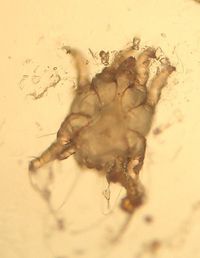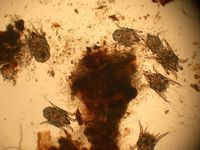Difference between revisions of "Otodectes cynotis"
| Line 30: | Line 30: | ||
| − | + | <big><b>Also see: | |
:[[Otitis Externa - Cat and Dog|Ear Mites in Cats and Dogs]] | :[[Otitis Externa - Cat and Dog|Ear Mites in Cats and Dogs]] | ||
| − | :[[Mites - Ferrets#Ear Mites|Ear Mites in Ferrets]]</b></big> | + | :[[Mites - Ferrets#Ear Mites|Ear Mites in Ferrets]] |
| − | + | </b></big> | |
{{Learning | {{Learning | ||
|flashcards = [[Mites_Flashcards|Mites Flashcards]] | |flashcards = [[Mites_Flashcards|Mites Flashcards]] | ||
Revision as of 13:25, 16 July 2011
| Otodectes cynotis | |
|---|---|
| Phylum | Arthropoda |
| Class | Arachnida |
| Order | Astigmata |
| Family | Psoroptidia |
| Genus | Otodectes |
| Species | O.cynotis |
Also known as: Ear mite
Introduction
Otodectes cynotis mites are surface mites. They are the cause of otodectic otitis, the most common mange of dogs and cats in the world. They are also found in the fox and the ferret. The mites inhabit the inner ear and feed on ear debris, they appear white in colour.
Identification
The mites have closed keratinous bars, apodemes on their ventral surface. They are smaller in size than psoroptes cuniculi and have short pedicles on their first and second pairs of legs.
Lifecycle
The Life cycle of an Otodectes mite takes 3 weeks. The females lay around five eggs a day on the surface of the ear canal. Four days later, larvae hatch and become nymphs. There are two nymphal stages before an adult mite is formed.
Pathogenesis
The majority of cats harbour the mites, however only a few show symptoms. Transmission of the mites occurs whilst kittens are suckling. The mites are a common cause of otitis externa in dogs, which leads to the production of a brown waxy exudate. Secondary infection can also occur.
Also see:
| Otodectes cynotis Learning Resources | |
|---|---|
 Test your knowledge using flashcard type questions |
Mites Flashcards |
 Search for recent publications via CAB Abstract (CABI log in required) |
Otodectes cynotis publications |
| This article has been peer reviewed but is awaiting expert review. If you would like to help with this, please see more information about expert reviewing. |

